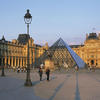More about Spring
- All
- Info
- Shop

Sr. Contributor
Giuseppe Arcimboldo’s mom must have always been on his case about eating his vegetables.
This guy loves produce...and pretty much anything else that grows from the ground. Arcimboldo hit his artistic stride just after the Italian Renaissance and found his place within the Mannerist movement. This allowed him to explore the art of Leonardo da Vinci, who also intensely studied the natural world for his art. Unlike da Vinci, however, Arcimboldo was more interested in plants than dead bodies, and flowers, vegetables, and fruits dominate his paintings that personify the seasons of the year and the elements.
If you feel a bit of déjà vu when you look at this painting that uses the flora of spring to represent the season, your eyes do not deceive you. Just like the bronze sculpture of a dancer wearing a tutu made of tulle by Edgar Degas, Arcimboldo’s Seasons paintings are in multiple institutions. Arcimboldo painted the original series The Seasons in 1563 for Emperor Maximilian II, a ruler of the Habsburg family who reigned in Vienna. The original paintings were such a hit that they eventually took many forms.
Arcimboldo’s part-plant, part-humanoid forms were meant to be both amusing and symbolic. The verdant portraits signified Maximilian’s success and represented the abundance of his empire. Almost a decade after Arcimboldo presented the series to Maximilian, Maximilian allowed the artist to stage a festival centered on his representations of the seasons, in which he played the part of winter during the festival’s play. The Emperor loved the series so much that he also commissioned Arcimboldo to paint reproductions to give as gifts to friends and fellow politicians. This particular painting comes from a series that Arcimboldo painted in 1573 for Augustus of Saxony, who controlled a state within Maximilian’s Holy Roman Empire.
Maximilian wasn’t the only Habsburg with an eye for art. This large and complex family helped shape the trajectory of Western art history for centuries. Charles V, first a King of Spain and then a Holy Roman Emperor, descended from the Habsburg lineage and was a famous patron of Titian, who painted The Rape of Europa for his son Philip II. Although the Habsburgs first acted as patrons of great art, they later became the leaders whom modernists abhorred and reacted against. After Habsburg rule took a disastrous turn, artists like Gustav Klimt and Egon Schiele weaponized their art against the decadent monarchs who ruled their native Austria.
Sources
- Education. “An Eye for Art - Questioning Traditions - Giuseppe Arcimboldo.” National Gallery of Art. https://www.nga.gov/content/dam/ngaweb/Education/learning-resources/an-…. Accessed November 25, 2018.
- Jones, Jonathan. “The Habsburgs shaped the story of Europe - and of its art.” The Guardian. Art. July 25, 2011. https://www.theguardian.com/artanddesign/jonathanjonesblog/2011/jul/25/…. Accessed November 25, 2018.
- Louvre Museum. “Le Printemps, Giuseppe Arcimboldo.” Atlas Database of Exhibits. http://cartelen.louvre.fr/cartelen/visite?srv=car_not_frame&idNotice=14…. Accessed November 25, 2018.
- Tucker, Abigail. “Arcimboldo’s Feast for the Eyes.” Smithsonian Magazine. January 2011. https://www.smithsonianmag.com/arts-culture/arcimboldos-feast-for-the-e…. Accessed November 25, 2018.














